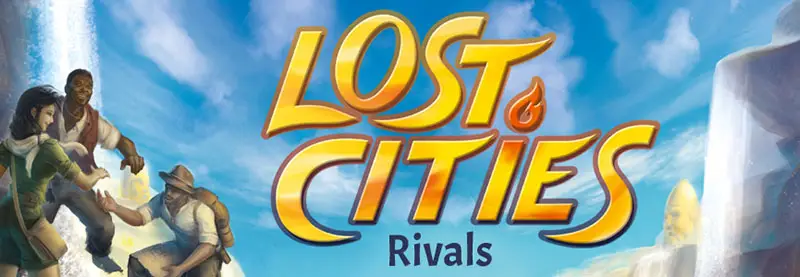
Use your cards to venture down expedition routes that take you to far-flung and mysterious corners of the Earth: to an abandoned mountain temple, a decaying circle of stone, a city sunken under the sea, an ancient Stone-Age settlement, and a town inside of a mountain.
Your goal is to plan the routes in such a way that they bring you the greatest possible fame. And if you are especially daring, you will also be able to wager on the success of your own expeditions.
But watch out: You are not the only one traveling! Which routes will you pursue and how much gold is it worth to you? Plan well and use your resources wisely. Only the player who has collected the most fame at the end of the game will be the winner.
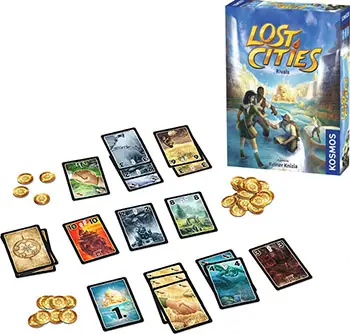
Components
- 65 Expedition cards
- Starting player card
- 15 Wager cards
- 10 Starting wager cards
- 36 Gold coins
- Instructions
Setup
Shuffle the ten starting wager cards face down. Deal two starting wager cards, face up, to each player. Be sure that each player has two different- colored starting wager cards. Place any unused starting wager cards back in the game box.
Then, shuffle the 65 expedition cards and the 15 wager cards together face down and divide them into four more or less equal piles.
Position one of these in the center of the table as a starting draw pile and set the other three piles to the side but still within reach. Next, divide the 36 gold coins evenly among everyone.
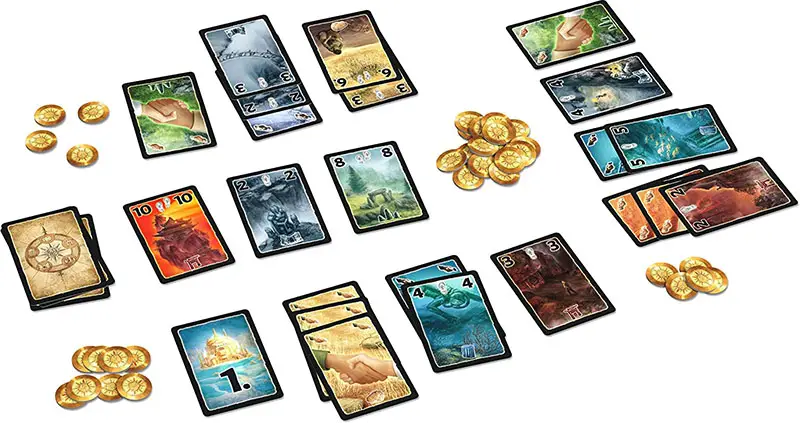
Object of the Game
Your goal is to have your expeditions win you as much fame as possible by the end of the game. An expedition always consists of a series of cards of a single color.
The number values between two cards in a series always have to be equal or increasing, in the order in which the cards are played. At the start of each series, you can also play wager cards to increase the value of that expedition.
At the end of the game, calculate the value of each expedition that has at least one card in it to determine the winner.
Game Play
The player whose birthday was the most recent will get the starting player card and start the game. After that, continue in a clockwise direction.
On your turn, you must perform exactly one action: uncover OR auction.
Uncover
Turn over the top card from the draw pile and place it face up next to the pile. If more cards are uncovered in subsequent turns, place them next to one another in a row. This is called the display.
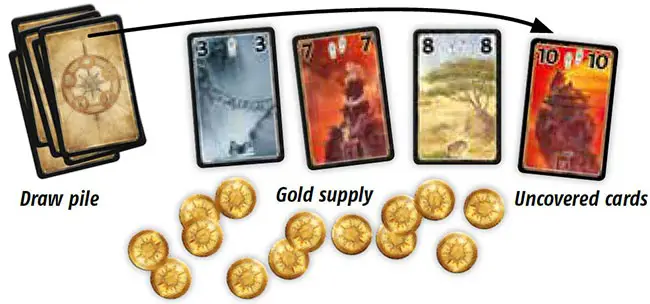
Note: During the course of the game, you might uncover a card that no one can use. Return these cards to the box face down. You will not uncover another card to replace it!
Auction
To start an auction for the cards in the display, you must bid at least one gold coin. Then, continuing in a clockwise direction, each player must either make a higher bid or pass.
If you pass, you drop out of the auction. If, however, you have made a bid and it comes around to your turn again, you can either make a higher bid or pass, and so on. The auction ends when everyone has passed except for one final person.
This person places the number of gold coins of the winning bid in the center of the table, thus creating the gold supply.
This gives the highest bidder access to the display cards. That player may
add as many of the cards from the display as he or she likes to his or her own expeditions (see page 4, Undertaking Expeditions), AND
return one card from the display face down to the game box, if he or she wants.
Any display cards that are neither added to your expeditions nor taken out of the game will remain face up in the display and remain available for the next auction.
Finally, the highest bidder turns over the top card in the draw pile and places it in the display. This ends the auction. Whoever is sitting next to the highest bidder in a clockwise direction will get the starting player card and takes the first turn of the round.
Note: In other words, if the person who wins the auction is not the one who started it, the playing sequence will change because play will continue with the player following the highest bidder.
When the last card in the draw pile is turned over, play is interrupted. When that happens, divide the gold in the supply evenly among all the players. Any extra gold coins should remain in the supply.
Then take one of the card piles you set aside and place it next to the display as the new draw pile, and the next player resumes play.
Undertaking Expeditions
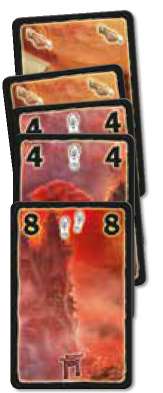
Add one or more cards from the display to one or more of your expeditions. You can begin new expeditions or expand expeditions that you have already started by laying cards down on the table in front of you.
All of the cards lying in front of you are your personal expeditions. You are the only one allowed to place cards on them during the course of play!
When you place the first card of a given color in front of you, it begins the expedition. All further cards of this same color that you want to use will have to be added to this expedition. When you do that, place the cards slightly offset from one another so that you can easily read the numbers of all the cards, like what is shown here.
You can only use wager cards at the beginning of an expedition, before using any cards that have a number value. You are allowed to use more than one wager card of a given color.
Each card that you want to add to one of your already existing expeditions must have a value equal to or higher than the card that was most recently added.
Note: During the game, you may find that some cards become unusable for your expedition - for example, if you have an expedition containing a red "4" and the red "8", and later a red "3" becomes available in the display.
In this case, you cannot use the red "3". But you should take a look at who might still be able to use this card, because you are allowed to take one card from the display out of the game when you win an auction.
Detailed example:
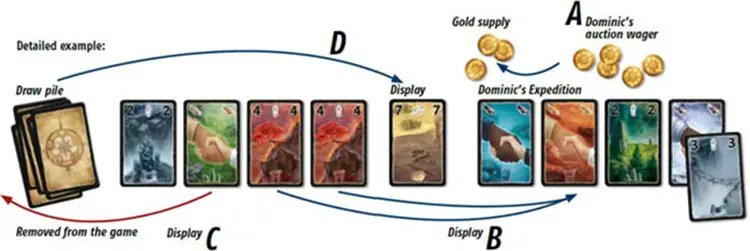
It is Sabrina's turn, and she starts an auction. She bids 1 gold coin. The next player in a clockwise direction is Jonas, who must decide whether he wants to submit a higher bid or pass.
He decides to pass. Daniela raises to 2 gold coins, Dominic to 3. Now it's Sabrina's turn again, and she bids 4 gold coins. Jonas has already dropped out, and cannot bid any more. Daniela passes, while Dominic raises the bid again to 5 gold coins.
That is too much for Sabrina, who passes. So Dominic wins the auction. He first pays 5 gold coins into the gold supply A and then takes the 2 red "4" cards for one of his expeditions B.
Since he can no longer use the white "2" or the green wager card, he returns the green wager card to the box C. The white "2" remains lying in the display. Finally, he turns over another card from the draw pile: the yellow "7" D. This ends the auction, and the next player in a clockwise direction - Sabrina - takes the starting player card, and it is her turn again.
End of the Game
The game ends as soon as you turn over the final card from the final pile. No more gold coins will be distributed from the supply!
Then it's time to add up the points for your expeditions. To do that, review each expedition one by one. Each footprint counts as one victory point.
Wager cards raise the value of an entire expedition. One wager card doubles the value of an expedition; two wager cards triple the value, and so on.
Finally, for each expedition with four or more number cards there is a bonus of eight victory points.
Note: This bonus is not multiplied by wager cards!
Also, each gold coin is worth one victory point. Whoever has the most victory points is the winner!
Scoring Example:
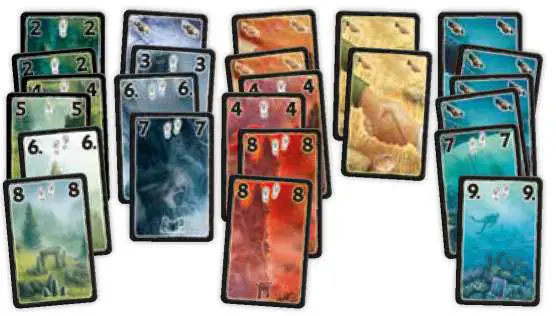
Green: 8 victory points; white: 5 x 2 = 10 victory points; red: 6 x 3 = 18 victory points; yellow: 0 victory points; blue: 4 x 5 = 20 victory points.
In addition, there is another bonus of 8 victory points each for green and red.
So in total, for your expeditions you get 8 + 10 + 18 + 0 + 20 + 8 + 8 = 72 victory points
Continue Reading


